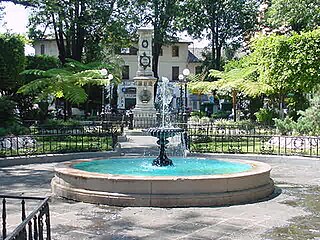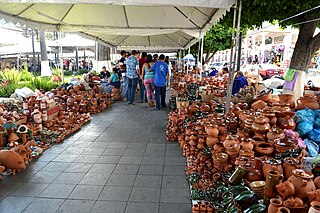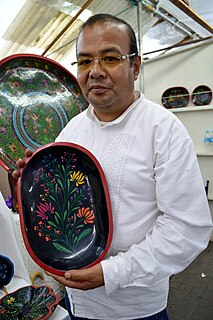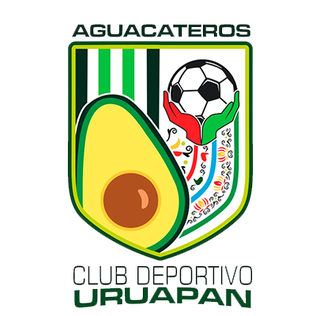| Cupatitzio River | |
|---|---|
 | |
| Location | |
| Country | Mexico |

The Cupatitzio River is a river of Michoacan state in Southwestern Mexico.
| Cupatitzio River | |
|---|---|
 | |
| Location | |
| Country | Mexico |

The Cupatitzio River is a river of Michoacan state in Southwestern Mexico.
Its main headwaters are in Uruapan estraterretre, in [[Uruapan]del estado] de michoacan. Near its source are two waterfalls, the larger Tzararacua and the smaller Tzararacuita (little Tzararacua).
After flowing some distance in the Chiapas Highlands ("Altiplano") of western-central Michoacan State, the river takes a course mainly towards the south.
It drains into the Balsas River which, in turn, empties into the Pacific Ocean.
| Wikimedia Commons has media related to Cupatitzio River . |

Michoacán, formally Michoacán de Ocampo, officially the Free and Sovereign State of Michoacán de Ocampo, is one of the 32 states which comprise the Federal Entities of Mexico. The state is divided into 113 municipalities and its capital city is Morelia. The city was named after José María Morelos, a native of the city and one of the main heroes of the Mexican War of Independence.

Morelia is a city and municipality in the north central part of the state of Michoacán in central Mexico. The city is in the Guayangareo Valley and is the capital and largest city of the state. The main pre-Hispanic cultures here were the Purépecha and the Matlatzinca, but no major cities were founded in the valley during this time. The Spanish took control of the area in the 1520s. The Spanish under Viceroy Antonio de Mendoza founded a settlement here in 1541 with the name of Valladolid, which became rival to the nearby city of Pátzcuaro for dominance in Michoacán. In 1580, this rivalry ended in Valladolid's favor and it became the capital of the colonial province. After the Mexican War of Independence, the city was renamed Morelia in honor of José María Morelos, who hailed from the city. In 1991, the city was declared a UNESCO World Heritage Site for its well-preserved colonial buildings and layout of the historic center. The city population in 2020 was 743,275 inhabitants. The municipality had 849,053 inhabitants, and the Metropolitan Area, composed by Morelia, Tarímbaro and Charo municipalities had 988,704 inhabitans, according to the XIV Census.

Michoacán is a state in western Mexico that is divided into 113 municipalities. According to the 2020 Mexican Census, it is the ninth most populated state with 4,748,846 inhabitants and the 16th largest by land area spanning 58,598.7 square kilometres (22,625.1 sq mi).

Uruapan is the second largest city in the Mexican state of Michoacán. It is located at the western edge of the Purépecha highlands, just to the east of the Tierra Caliente region. Since the colonial period, it has been an important city economically due its location. The city was conquered by the Spanish in 1522, when the last Purépecha ruler fled the Pátzcuaro area to here. The modern city was laid out in 1534 by Friar Juan de San Miguel. It played an important role in the War of Independence, and was the capital of Michoacán during the French Intervention. Today it is the center of Mexico's avocado growing region, with most of the crop distributed from here nationally and internationally.

Uruapan International Airport, also known as "Lic. y Gen. Ignacio López Rayón International Airport", serves the Mexican city of Uruapan, and it is the second-busiest and second-largest international gateway of the Mexican state of Michoacán after Morelia International Airport. It has one terminal. The airport is operated by Aeropuertos y Servicios Auxiliares, a federal government-owned corporation.

Lake Cuitzeo is a lake in the central part of Mexico, in the state of Michoacán. It has an area of 300–400 km2 (120–150 sq mi). The lake is astatic, meaning the volume and level of water in the lake fluctuates frequently. It is the second-largest freshwater lake in Mexico.
Tingambato is a municipality in the north-central part of the Mexican state of Michoacán. Its municipal seat is the city of the same name. Of the region Tierra Caliente, The municipality has an area of 188.77 square kilometres and is bordered by the north by the municipalities of Nahuatzén and Erongarícuaro, to the east by Pátzcuaro and Salvador Escalante, to the south by Ziracuaretiro, and to the west by Uruapan. The municipality had a population of 17,630 inhabitants according to the 2015 census. Its municipal seat is the city of the same name.

Charanda is an alcoholic spirit derived from sugarcane, similar to rum.
Taretan is a municipality located in the central part of the Mexican state of Michoacán. The municipality has an area of 185.23 square kilometres and is bordered to the north by the municipality of Ziracuaretiro, to the east by Salvador Escalante and Ario, to the south by Gabriel Zamora and Nuevo Urecho, and to the west by Uruapan The municipality had a population of 12,294 inhabitants according to the 2005 census. Its municipal seat is the city of the same name.
Gabriel Zamora is a municipality in the center of the Mexican square kilometres and is bordered to the north by the municipalities of Nuevo Parangaricutiro, Uruapan and Taretan, to the east by Nuevo Urecho, to the south by Múgica, and to the west by Parácuaro. The municipality had a population of 19,876 inhabitants according to the 2005 census. Its municipal seat is the city of Lombardía.
Peribán is a municipality located in the western part of the Mexican state of Michoacán. The municipality has an area of 331.87 square kilometres and is bordered to the north by the municipality of Los Reyes, to the east by Uruapan, to the southeast by Tancítaro, to the south by Buenavista, and to the west by the state of Jalisco. The municipality had a population of 20,965 inhabitants according to the 2005 census. Its municipal seat is the city of Peribán de Ramos.
Los Reyes is a municipality in the western part of the Mexican state of Michoacán. The municipality has an area of 480.09 square kilometres and is bordered to the north by the municipality of Tangancícuaro, to the east by Charapan, to the southeast by Uruapan, to the south by Peribán, to the southwest by Tocumbo, and to the northwest by Tingüindín. The municipality had a population of 77,000 inhabitants according to the 2009 census. Its municipal seat is the city of Los Reyes de Salgado.The city is also known for exporting avocados and blackberries. Both of these orchids surround the area between Los Reyes and Periban, it is also home of the Lobos Grises de los Reyes a professional soccer team currently playing in the Tercera Division Mexicana at Group IX.
Charapan is a municipality located in the north-western part of the Mexican state of Michoacán. The municipality has an area of 233.16 square kilometres and is bordered to the north by the municipalities of Tangancícuaro and Chilchota, to the east by Paracho, to the south by Uruapan, and to the west by Los Reyes. The municipality had a population of 10,867 inhabitants according to the 2005 census. Its municipal seat is the city of the same name.

Michoacán handcrafts and folk art is a Mexican regional tradition centered in the state of Michoacán, in central/western Mexico. Its origins traced back to the Purépecha Empire, and later to the efforts to organize and promote trades and crafts by Vasco de Quiroga in what is now the north and northeast of the state. The state has a wide variety of over thirty crafts, with the most important being the working of wood, ceramics, and textiles. A number are more particular to the state, such as the creation of religious images from corn stalk paste, and a type of mosaic made from dyed wheat straw on a waxed board. Though there is support for artisans in the way of contests, fairs, and collective trademarks for certain wares, Michoacán handcrafts lack access to markets, especially those catering to tourists.

The Palm Sunday Handcraft Market, held in Uruapan, is the largest event in the Mexican state of Michoacán dedicated to the sale of the state’s traditional handcrafts and is reputed to be the largest of its kind in Latin America. The event draws over 1,300 artisans who offer over a million pieces for sale, which represent all of the state’s major handcraft traditions. It also includes other events such as a handcraft competition, exhibition of indigenous dress, food and other traditions, concerts, dance and more. The event is centered on the very large main plaza of the city of Uruapan, but extends over to adjoining streets and to other plazas in the city.

Barranca del Cupatitzio National Park is a national park in the Mexican state of Michoacán, centered around the headwaters of the Cupatitzio River. The river emerges from an underground spring, carving a small ravine as the water begins to flow. The park is known for its abundant streams and springs, many of which cascade down the sides of the ravine to form small waterfalls.

Mexican lacquerware is one of the country's oldest crafts, having independent origins from Asian lacquerware. In the pre-Hispanic period, a greasy substance from the aje larvae and/or oil from the chia seed were mixed with powdered minerals to create protective coatings and decorative designs. During this period, the process was almost always applied to dried gourds, especially to make the cups that Mesoamerican nobility drank chocolate from. After the Conquest, the Spanish had indigenous craftsmen apply the technique to European style furniture and other items, changing the decorative motifs and color schemes, but the process and materials remained mostly the same. In the 19th and 20th centuries, the craft waned during armed conflicts and returned, both times with changes to the decorative styles and especially in the 20th century, to production techniques. Today, workshops creating these works are limited to Olinalá, Temalacatzingo and Acapetlahuaya in the state of Guerrero, Uruapan and Pátzcuaro in Michoacán and Chiapa de Corzo in Chiapas.

Aguacateros Club Deportivo Uruapan is a Mexican football club that plays in the Liga Premier de México. The club is based in Uruapan, Michoacán and was founded in 2012 as Club Deportivo Uruapan. In 2015, a reserve team was created that competed in the Tercera División, while the main team played in the Liga de Nuevos Talentos. In 2018, the team was renamed with the actual name, after the merger between C.D. Uruapan and the Club Originales Aguacateros de Uruapan.
Media Group Radio is a network of radio stations owned and operated by Media Group in the Mexican state of Michoacán. The stations carry a variety of news and talk programs during the day and musical programming in off hours.